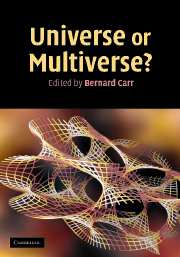Book contents
- Frontmatter
- Contents
- List of contributors
- Preface
- Acknowledgements
- Editorial note
- Part I Overviews
- Part II Cosmology and astrophysics
- 4 Cosmology and the multiverse
- 5 The anthropic principle revisited
- 6 Cosmology from the top down
- 7 The multiverse hierarchy
- 8 The inflationary multiverse
- 9 A model of anthropic reasoning: the dark to ordinary matter ratio
- 10 Anthropic predictions: the case of the cosmological constant
- 11 The definition and classification of universes
- 12 M/string theory and anthropic reasoning
- 13 The anthropic principle, dark energy and the LHC
- Part III Particle physics and quantum theory
- Part IV More general philosophical issues
- Index
- References
8 - The inflationary multiverse
Published online by Cambridge University Press: 05 July 2014
- Frontmatter
- Contents
- List of contributors
- Preface
- Acknowledgements
- Editorial note
- Part I Overviews
- Part II Cosmology and astrophysics
- 4 Cosmology and the multiverse
- 5 The anthropic principle revisited
- 6 Cosmology from the top down
- 7 The multiverse hierarchy
- 8 The inflationary multiverse
- 9 A model of anthropic reasoning: the dark to ordinary matter ratio
- 10 Anthropic predictions: the case of the cosmological constant
- 11 The definition and classification of universes
- 12 M/string theory and anthropic reasoning
- 13 The anthropic principle, dark energy and the LHC
- Part III Particle physics and quantum theory
- Part IV More general philosophical issues
- Index
- References
Summary
Introduction
At the beginning of the 1980s, when the inflationary theory was first proposed, one of our main goals was to explain the amazing uniformity of the Universe. We were trying to find out why the Universe looks approximately the same in all directions. Of course, locally the Universe does not look uniform — there are such large deviations from uniformity as planets, stars and galaxies. But if one considers the density of matter on scales comparable to the size of the observable Universe, lobs ~ 1028 cm, one finds that this is uniform to an accuracy better than one part in 10 000. The most surprising thing about this is that, according to the standard big bang theory, the distant parts of the Universe which we can see with a powerful telescope were not in causal contact at the time of the big bang and could not have been in such contact until very late stages of cosmic evolution. So one could only wonder what made these distant parts of the Universe so similar to each other.
In the absence of any reasonable explanation, cosmologists invented the so-called ‘cosmological principle’, which claims that the Universe must be uniform. But the Universe is not perfectly uniform, since it contains inho-mogeneities — such as stars and galaxies — which are crucial for life. Because of these small but important violations, the cosmological principle cannot be a true principle of nature, just like a person who takes only small bribes cannot be called a man of principle.
- Type
- Chapter
- Information
- Universe or Multiverse? , pp. 127 - 150Publisher: Cambridge University PressPrint publication year: 2007
References
- 6
- Cited by



